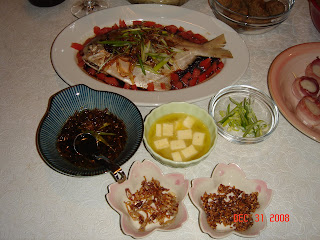I woke up this morning craving for something i have'nt had for a long time, a filipino
"agahan" or
"umagahan" (early morning b-fast). So, i requested Andie, if we can have one today, she came up with
"Longganisa " ( a native filipino b-fast sausage or chorizo)scrambled eggs with tomatoes,my favorite garlic fried rice, and a dried fish called
espada (we got this from my sister-in-law as
pasalubong from the philippines) these delicacies are among the most loved traditional Filipino breakfast items. Depending on which province or region the
longganisa originates, it can be sweet , spicy, garlicky , colored or uncolored.
 Longganisa
Longganisa for breakfast is so popularly Pinoy that it is actually served at the humblest
turo-turo & carinderia and deluxe hotels (it reminds me of the time when i'm still working at the Shangri-la Edsa Manila,we used to have this on the menu, called the "
longsilog" together with other popular b-fast items such as
tapa, a marinated thin sliced of beef and
tocino,a sweet cured pork )


My son , Ardie is the only one who ate his usual bowl of cheerios and zippy cup of milk :-)

Cheer's Bukchoi !!! Daddy's happy again ;-)
 canapes - dungeness crabmeat & mango salad on a corn chip cup/grilled eggplant roll with sundried tomato & provolone cheese
canapes - dungeness crabmeat & mango salad on a corn chip cup/grilled eggplant roll with sundried tomato & provolone cheese Szechuan crusted Ahi Tuna , curry aioli & taro chips
Szechuan crusted Ahi Tuna , curry aioli & taro chips
 Assorted Nigiri sushi and maki rolls
Assorted Nigiri sushi and maki rolls A Japanese Sushi & Sashimi buffet platter
A Japanese Sushi & Sashimi buffet platter Seared Ahi Tuna
Seared Ahi Tuna Italian Pasta Salad
Italian Pasta Salad Mediterranean Blackened Prawn Salad
Mediterranean Blackened Prawn Salad









